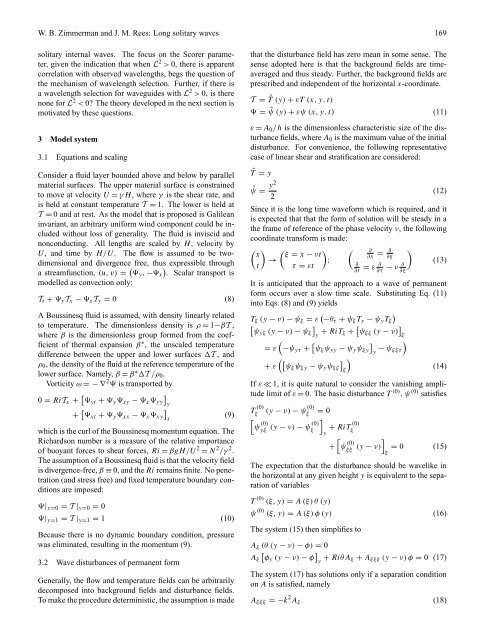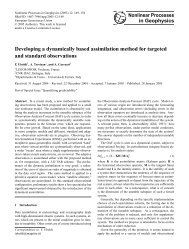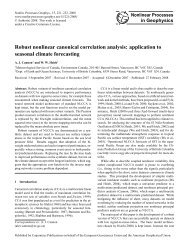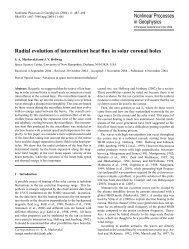Long solitary internal waves in stable stratifications
Long solitary internal waves in stable stratifications
Long solitary internal waves in stable stratifications
Create successful ePaper yourself
Turn your PDF publications into a flip-book with our unique Google optimized e-Paper software.
W. B. Zimmerman and J. M. Rees: <strong>Long</strong> <strong>solitary</strong> <strong>waves</strong> 169<br />
<strong>solitary</strong> <strong><strong>in</strong>ternal</strong> <strong>waves</strong>. The focus on the Scorer parameter,<br />
given the <strong>in</strong>dication that when L 2 > 0, there is apparent<br />
correlation with observed wavelengths, begs the question of<br />
the mechanism of wavelength selection. Further, if there is<br />
a wavelength selection for waveguides with L 2 > 0, is there<br />
none for L 2 < 0? The theory developed <strong>in</strong> the next section is<br />
motivated by these questions.<br />
3 Model system<br />
3.1 Equations and scal<strong>in</strong>g<br />
Consider a fluid layer bounded above and below by parallel<br />
material surfaces. The upper material surface is constra<strong>in</strong>ed<br />
to move at velocity U = γ H , where γ is the shear rate, and<br />
is held at constant temperature T = 1. The lower is held at<br />
T = 0 and at rest. As the model that is proposed is Galilean<br />
<strong>in</strong>variant, an arbitrary uniform w<strong>in</strong>d component could be <strong>in</strong>cluded<br />
without loss of generality. The fluid is <strong>in</strong>viscid and<br />
nonconduct<strong>in</strong>g. All lengths are scaled by H , velocity by<br />
U, and time by H/U. The flow is assumed to be twodimensional<br />
and divergence free, thus expressible through<br />
a streamfunction, (u, v) = ( )<br />
y , − x . Scalar transport is<br />
modelled as convection only:<br />
T t + y T x − x T y = 0 (8)<br />
A Bouss<strong>in</strong>esq fluid is assumed, with density l<strong>in</strong>early related<br />
to temperature. The dimensionless density is ρ = 1−βT ,<br />
where β is the dimensionless group formed from the coefficient<br />
of thermal expansion β ∗ , the unscaled temperature<br />
difference between the upper and lower surfaces T , and<br />
ρ 0 , the density of the fluid at the reference temperature of the<br />
lower surface. Namely, β = β ∗ T /ρ 0 .<br />
Vorticity ω = − ∇ 2 is transported by<br />
0 = RiT x + [ yt + y xy − x yy<br />
]y<br />
+ [ xt + y xx − x xy<br />
]x<br />
(9)<br />
which is the curl of the Bouss<strong>in</strong>esq momentum equation. The<br />
Richardson number is a measure of the relative importance<br />
of buoyant forces to shear forces, Ri = βgH /U 2 = N 2 /γ 2 .<br />
The assumption of a Bouss<strong>in</strong>esq fluid is that the velocity field<br />
is divergence-free, β ≡ 0, and the Ri rema<strong>in</strong>s f<strong>in</strong>ite. No penetration<br />
(and stress free) and fixed temperature boundary conditions<br />
are imposed:<br />
| y=0 = T | y=0 = 0<br />
| y=1 = T | y=1 = 1 (10)<br />
Because there is no dynamic boundary condition, pressure<br />
was elim<strong>in</strong>ated, result<strong>in</strong>g <strong>in</strong> the momentum (9).<br />
3.2 Wave disturbances of permanent form<br />
Generally, the flow and temperature fields can be arbitrarily<br />
decomposed <strong>in</strong>to background fields and disturbance fields.<br />
To make the procedure determ<strong>in</strong>istic, the assumption is made<br />
that the disturbance field has zero mean <strong>in</strong> some sense. The<br />
sense adopted here is that the background fields are timeaveraged<br />
and thus steady. Further, the background fields are<br />
prescribed and <strong>in</strong>dependent of the horizontal x-coord<strong>in</strong>ate.<br />
T = ˆT (y) + εT (x, y, t)<br />
= ˆψ (y) + εψ (x, y, t) (11)<br />
ε = A 0 /h is the dimensionless characteristic size of the disturbance<br />
fields, where A 0 is the maximum value of the <strong>in</strong>itial<br />
disturbance. For convenience, the follow<strong>in</strong>g representative<br />
case of l<strong>in</strong>ear shear and stratification are considered:<br />
ˆT = y<br />
ˆψ = y2<br />
2<br />
(12)<br />
S<strong>in</strong>ce it is the long time waveform which is required, and it<br />
is expected that that the form of solution will be steady <strong>in</strong> a<br />
the frame of reference of the phase velocity ν, the follow<strong>in</strong>g<br />
coord<strong>in</strong>ate transform is made:<br />
( ) ( )<br />
x ξ = x − νt<br />
→<br />
;<br />
t τ = εt<br />
( ∂<br />
∂x<br />
=<br />
∂ξ<br />
∂<br />
∂<br />
∂t<br />
= ε ∂<br />
∂τ − ν ∂<br />
∂ξ<br />
)<br />
(13)<br />
It is anticipated that the approach to a wave of permanent<br />
form occurs over a slow time scale. Substitut<strong>in</strong>g Eq. (11)<br />
<strong>in</strong>to Eqs. (8) and (9) yields<br />
T ξ (y − ν) − ψ ξ = ε ( −θ τ + ψ ξ T y − ψ y T ξ<br />
)<br />
[<br />
ψyξ (y − ν) − ψ ξ<br />
]<br />
y + RiT ξ + [ ψ ξξ (y − ν) ] ξ<br />
= ε<br />
(−ψ yτ + [ ] )<br />
ψ ξ ψ yy − ψ y ψ ξy y − ψ ξξτ<br />
( [ψξ ] )<br />
+ ε ψ ξy − ψ y ψ ξξ<br />
ξ<br />
(14)<br />
If ε ≪ 1, it is quite natural to consider the vanish<strong>in</strong>g amplitude<br />
limit of ε = 0. The basic disturbance T (0) , ψ (0) satisfies<br />
T (0)<br />
ξ<br />
(y − ν) − ψ (0)<br />
ξ<br />
= 0<br />
[<br />
]<br />
ψ (0)<br />
(0)<br />
yξ<br />
(y − ν) − ψ(0)<br />
ξ<br />
+ RiT<br />
y<br />
ξ<br />
[<br />
+ ψ (0)<br />
ξξ<br />
]ξ (y − ν) = 0 (15)<br />
The expectation that the disturbance should be wavelike <strong>in</strong><br />
the horizontal at any given height y is equivalent to the separation<br />
of variables<br />
T (0) (ξ, y) = A (ξ) θ (y)<br />
ψ (0) (ξ, y) = A (ξ) φ (y) (16)<br />
The system (15) then simplifies to<br />
A ξ (θ (y − ν) − φ) = 0<br />
A ξ<br />
[<br />
φy (y − ν) − φ ] y + RiθA ξ + A ξξξ (y − ν) φ = 0 (17)<br />
The system (17) has solutions only if a separation condition<br />
on A is satisfied, namely<br />
A ξξξ = −k 2 A ξ (18)






